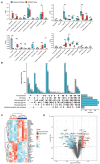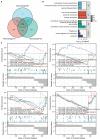Macrophages-Related Genes Biomarkers in the Deterioration of Atherosclerosis
- PMID: 35845072
- PMCID: PMC9282674
- DOI: 10.3389/fcvm.2022.890321
Macrophages-Related Genes Biomarkers in the Deterioration of Atherosclerosis
Abstract
Background: The macrophages are involved in all stages of cardiovascular diseases, demonstrating the correlation between inflammation, atherosclerosis, and myocardial infarction (MI). Here, we aim to investigate macrophages-related genes in the deterioration of atherosclerosis.
Methods: GSE41571 was downloaded and the abundance of immune cells was estimated by utilizing the xCell. By utilizing the limma test and correlation analysis, differentially expressed macrophages-related genes (DEMRGs) were documented. The functional pathways and the protein-protein interaction (PPI) network were analyzed and the hub DEMRGs were obtained. The hub DEMRGs and their interactions were analyzed using NetworkAnalyst 3.0 and for validation, the expressions of hub DEMRGs were analyzed using the GSE135055 and GSE116250 datasets as well as atherosclerosis and MI mice model.
Results: A total of 509 differentially expressed genes (DEGs) were correlated with the abundance of macrophages and were identified as DEMRGs (Pearson correlation coefficients (PCC) > 0.6), which were mainly enriched in extracellular structure organization, lysosomal membrane, MHC protein complex binding, and so on. After screening out, 28 hub DEMRGs were obtained with degrees ≥20, including GNAI1 (degree = 113), MRPS2 (degree = 56), HCK (degree = 45), SOCS3 (degree = 40), NET1 (degree = 28), and so on. After validating using Gene Expression Omnibus (GEO) datasets and the atherosclerosis and MI mice model, eight proteins were validated using ApoE-/- and C57 mice. The expression levels of proteins, including SYNJ2, NET1, FZD7, LCP2, HCK, GNB2, and PPP4C were positively correlated to left ventricular ejection fraction (LVEF), while that of EIF4EBP1 was negatively correlated to LVEF.
Conclusion: The screened hub DEMRGs, SYNJ2, NET1, FZD7, LCP2, HCK, GNB2, EIF4EBP1, and PPP4C, may be therapeutic targets for treatment and prediction in the patients with plaque progression and MI recurrent events. The kit of the eight hub DEMRGs may test plaque progression and MI recurrent events and help in the diagnosis and treatment of MI-induced heart failure (HF), thus decreasing mortality and morbidity.
Keywords: GO/KEGG pathways analysis; GSEA; PPI; atherosclerosis; differentially expressed genes; immune infiltration; macrophages; progression.
Copyright © 2022 Zheng, Qi, Gao, Qi, Liu, Wang, Feng, Cheng, Luo and Li.
Conflict of interest statement
The authors declare that the research was conducted in the absence of any commercial or financial relationships that could be construed as a potential conflict of interest.
Figures







Similar articles
-
Macrophage-Related Genes Biomarkers in Left Ventricular Remodeling Induced by Heart Failure.Rev Cardiovasc Med. 2022 Mar 18;23(3):109. doi: 10.31083/j.rcm2303109. Rev Cardiovasc Med. 2022. PMID: 35345276
-
Identification of hub biomarkers of myocardial infarction by single-cell sequencing, bioinformatics, and machine learning.Front Cardiovasc Med. 2022 Jul 25;9:939972. doi: 10.3389/fcvm.2022.939972. eCollection 2022. Front Cardiovasc Med. 2022. PMID: 35958412 Free PMC article.
-
Identification and validation of metabolism-related hub genes in idiopathic pulmonary fibrosis.Front Genet. 2023 Feb 27;14:1058582. doi: 10.3389/fgene.2023.1058582. eCollection 2023. Front Genet. 2023. PMID: 36923791 Free PMC article.
-
The Key Genes Underlying Pathophysiology Association between Plaque Instability and Progression of Myocardial Infarction.Dis Markers. 2021 Dec 9;2021:4300406. doi: 10.1155/2021/4300406. eCollection 2021. Dis Markers. 2021. PMID: 34925642 Free PMC article.
-
KLRD1, FOSL2 and LILRB3 as potential biomarkers for plaques progression in acute myocardial infarction and stable coronary artery disease.BMC Cardiovasc Disord. 2021 Jul 16;21(1):344. doi: 10.1186/s12872-021-01997-5. BMC Cardiovasc Disord. 2021. PMID: 34271875 Free PMC article.
Cited by
-
Identification of FZD7 as a potential ferroptosis-related diagnostic gene in endometriosis by bioinformatics analysis.Sci Rep. 2025 Feb 28;15(1):7172. doi: 10.1038/s41598-025-90803-9. Sci Rep. 2025. PMID: 40021920 Free PMC article.
-
Integrating the characteristic genes of macrophage pseudotime analysis in single-cell RNA-seq to construct a prediction model of atherosclerosis.Aging (Albany NY). 2023 Jul 8;15(13):6361-6379. doi: 10.18632/aging.204856. Epub 2023 Jul 8. Aging (Albany NY). 2023. PMID: 37421595 Free PMC article.
-
Potential Roles and Future Perspectives of Chitinase 3-like 1 in Macrophage Polarization and the Development of Diseases.Int J Mol Sci. 2023 Nov 9;24(22):16149. doi: 10.3390/ijms242216149. Int J Mol Sci. 2023. PMID: 38003338 Free PMC article. Review.
-
Targeting the Opioid System in Cardiovascular Disease: Liver Proteomic and Lipid Profile Effects of Naloxone in Atherosclerosis.Biomedicines. 2025 Jul 23;13(8):1802. doi: 10.3390/biomedicines13081802. Biomedicines. 2025. PMID: 40868056 Free PMC article.
-
Online application for the diagnosis of atherosclerosis by six genes.PLoS One. 2024 Apr 10;19(4):e0301912. doi: 10.1371/journal.pone.0301912. eCollection 2024. PLoS One. 2024. PMID: 38598492 Free PMC article.
References
-
- Naghavi M, Abajobir AA, Abbafati C, Abbas KM, Abd-Allah F, Abera SF, et al. . Global, regional, and national age-sex specific mortality for 264 causes of death, 1980–2016: a systematic analysis for the global burden of disease study 2016. Lancet. (2017) 390:1151–210. 10.1016/S0140-6736(17)32152-9 - DOI - PMC - PubMed
LinkOut - more resources
Full Text Sources
Research Materials
Miscellaneous

